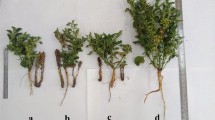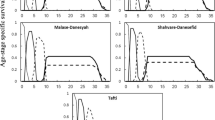Abstract
The cultivation ofPhytolacca dodecandra has been studied in Zimbabwe in order to initiate local production of the berries from which molluscicidal saponins can be extracted and used in schistosomiasis control programs. The effect of shading, water and nutrient type on growth and berry yield of an imported Ethiopian and a Zimbabwean cultivar were monitored. The molluscicidal potency and saponin concentration of the aqueous extracts of berries, harvested at the full grown, unripe development stage, were determined. There was a marked seasonal variation in berry production with both cultivars being highly productive in the dry season. The best growth and the highest berry yield was obtained with plants grown in full sunlight, under irrigation and with application of cattle manure. The Ethiopian cultivar showed in general better growth and higher berry yield than the Zimbabwean cultivar. Cultivation in shade gave a substantially lower berry yield and saponin concentration in both cultivars, compared to full sunlight. Irrigation was beneficial to the berry yield in both cultivars but lowered the saponin concentration in berries of the Ethiopian cultivar. However, it did not counteract the advantage of irrigation on the total yield. Addition of manure did significantly increase the growth and the berry yield of both cultivars compared to fertilizer application and to the control. The saponin concentration was in general lower with addition of manure, with exception of irrigated Ethiopian plants. The combination of cattle manure and irrigation resulted in the highest saponin yield. Although the two cultivars had different saponin patterns, these patterns and the relative proportions of the saponins were constant, irrespective of the treatments.
Resumen
Un extrait aqueux des baies de Phytolacca dodecandra contient des saponines toxiques á l’égard des mollusques, hôtes intermédiaires de la maladie tropique parasitaire schistosomiase. Cette plante a été sélectionnée comme la meilleur pour produire des matériaux molluscicides dans l’utilisation de programmes sanitaires dans le but de controller la schistosomiase. La culture de deux cultivars dePhytolacca dodecandra a été étudiée au Zimbabwe pour évaluer les meilleures circonstances de culture. Le plus grand rendement de baies et de saponines a été obtenu d’une culture ensoleillée, d’irrigation et d’engraissage avec des engrais d’animaux domestiques.
Similar content being viewed by others
Literature Cited
Aubert, S., M. C. Daunay, and E. Pochard. 1989. Steroidic saponins from eggplantSolarium melongema L II. Effects of cultural conditions genotypes and parthenocarpy. Agronomie Paris 9:752–758.
Bernath, J. 1986. Production ecology of secondary plant products. Pages 185–234in L. E. Craker and J. E. Simon, eds., Herbs spices and medicinal plants. Recent advances in botany, horticulture and pharmacology. Volume 1. Oryx Press.
Boyer, J. S. 1982. Plant productivity and environment. Science 218:443–448.
Chandiwana, S. K., N. O. Christensen, and F. Frandsen. 1987. Seasonal patterns in the transmission ofSchistosoma haematobium, S. matthei, andS. mansoni in the highveld region of Zimbabwe. Acta Tropica 44:433–444.
Chimbelu, E. G., and M. A. Shehata. 1987. A review of research in Zambia onPhytolacca dodecandra (Endod). Pages 109–126in L. Makhubu, A. Lemma, and D. Heyneman, eds., Endod II (Phytolacca dodecandra); Report of the Second International Workshop on Endod,Phytolacca dodecandra, Mbabane, Swaziland, April, 1986. Council on International and Public Affairs, New York.
Defago, G. 1977. The function of saponins in the resistance of plants to parasitic fungi. Bulletin de la Societe Botanique Suisse 87:79–132.
Donald, C. M., and J. Hamblin. 1976. The biological yield and harvest index of cereals as agronomic and plant breeding criteria. Advances in Agronomy 28:361–405.
Fluck, H. 1954. The influence of the soil on the content of active principles in medicinal plants. Journal of Pharmacy and Pharmacology 6:153–163.
Gershenzon, J. 1984. Changes in the levels of plant secondary metabolites under water and nutrient stress. Recent Advances in Phytochemistry 18: 273–320.
Kawanishi, F., Y. Nagaoka, H. Watanabe, H. Oshio, and K. Nakamoto. 1983. Cultivation ofBupleurumfalcatum. Journal of the Takeda Research Laboratories 42:57–63.
Lemma, A. 1965. A preliminary report on the molluscicidal property of endod (Phytolacca dodecandra). Ethiopian Medical Journal 3:187–190.
Litchfleld, J. T.,and F. Wilcoxon. 1949. A simplified method of evaluating dose-effect experiments. Journal of Pharmacology and Experimental Therapeutics 96:99–113.
Lugt, C. B. 1976. The cardiac-glycoside composition of differentDigitalis purpurea populations. Pharmacological Weekbulletin 111:441–445.
—. 1981.Phytolacca dodecandra berries as a means of controlling bilharzia transmitting snails. Litho Printers, Addis Ababa.
-. 1987. Feasability of growth and production of molluscicidal plants. Pages 231–244in K. E. Mott, ed., Plant Molluscicides. UNDP/World Bank/ WHO Special Program for Research and Training in Tropical Diseases. John Wiley & Sons Ltd.
Marston, A., and K. Hostettmann. 1987. Antifungal, molluscicidal and cytotoxic compounds from plants used in traditional medicine. Page 27in K. Hostettmann and P. J. Lea, eds., Proceedings of the Phytochemical Society of Europe, No. 27: Biologically active natural products. Oxford Science publications, Clarendon Press, Oxford.
McDermitt, D. K., and D. K. Loomis. 1981. Elemental composition of biomass and its relation to energy content, growth efficiency and growth yield. Annales of Botany 48:275–290.
Ndamba, J. 1993. Agronomic and other factors that influence the yield, molluscicidal potency and saponin content of the berries ofPhytolacca dodecandra. Ph.D. thesis. Royal Danish School of Pharmacy, Copenhagen, 113 pp.
—,and S. K. Chandiwana. 1988. The geographical variation in the molluscicidal potency ofPhytolacca dodecandra in Zimbabwe. Tropical and Geographical Medicine 40:34–38.
—, —,and N. Makaza. 1989. The use ofPhytolacca dodecandra berries in the control of trematode-transmitting snails in Zimbabwe. Acta Tropica 46:303–309.
—,E. Lemmich, and P. Mølgaard. 1994. In vestigation of the diurnal, ontogenetic and seasonal variation in the molluscicidal saponin content ofPhytolacca dodecandra aqueous berry extracts. Phytochemistry 35:95–99.
Parkhurst, R. M., B. M. Mthupha, Y. S. Liang, J. I. Bruce, J. D. H. Lambert, T. L. Collier, J. W. ApSimon, L. W. Yohannes, G. E. Heath, W. O. Jones, J. K. Stobaeus, and L. P. Makhubu. 1989. The molluscicidal activity ofPhytolacca dodecandra. 1. Location of the activating esterase. Biochemical and Biophysical Research Communication 158:436–439.
—,D. W. Thomas, W. A. Skinner, and L. W. Cary. 1973a. Molluscicidal saponins ofPhytolacca dodecandra: Lemmatoxin-C. Indian Journal of Chemistry 11:1192–1195.
—, —, —, and —. 1973b. Molluscicidal saponins ofPhytolacca dodecandra: Olenaoglycotoxin-A. Phytochemistry 12:1437–1442.
—, —, —, and —. 1974. Mollusicidal saponins ofPhytolacca dodecandra: Lemmatoxin. Canadian Journal of Chemistry 52:702–705.
Sniff, C. J., and V. de Clarke. 1967. The effect of snail surveillance in natural waterways on the transmission ofSchistosoma haematobium in Rhodesia. Central African Journal of Medicine 13:133–137.
Small, E., M. Jurzysta, and C. Nozzolillo. 1990. The evaluation of hemolytic saponin content in wild and cultivated alfalfa (Medicago sativa, Fabaceae). Economic Botany 44:226–235.
Tallarida, R. J., and R. B. Murray. 1981. Manual of pharmacologic calculations with computer programs. Springer-Verlag, New York.
Thiilborg, S. T., S. B. Christensen, C. Cornett, C. E. Olsen, and E. Lemmich. 1993. Molluscicidal saponins fromPhytolacca dodecandra. Phytochemistry 32:1167–1171.
—, —, —, —, and —. 1994. Molluscicidal saponins from a Zimbabwean strain ofPhytolacca dodecandra. Phytochemistry 36: 753–759.
Vetter, J., and E. Haraszri. 1987. Haemolytic saponin content of herbage. Acta Botanica Hungarica 33:431–436.
Webbe, G., ed. 1987. The toxicology of molluscicides. International Encyclopedia of Pharmacology and Therapeutics Section 125. Pergamon Press, Oxford.
WHO 1965. Molluscicide screening and evaluation. Bulletin of the World Health Organization 33:567–581.
—. 1983. The control of schistosomiasis. Report of a WHO Expert Committee. WHO Technical Report Series No. 728. WHO Geneva.
Wolde-Yohannes, L. 1983. Past and ongoing agrobotanical studies ofPhytolacca dodecandra (Endod) in Ethiopia. Pages 125–132in A. Lemma, D. Heyneman, and S. M. Silangwa, eds.,Phytolacca dodecandra (Endod). Towards controlling transmission of schistosomiasis with the use of a natural product. Final Report of the International Work shop, Lusaka, Zambia. Tycooly International Publishing Ltd., Dublin.
—,and H. Kloos. 1989. Agronomic and molluscicidal characteristics of three types of endod (Phytolacca dodecandra). Ethiopian Journal of Agricultural Science 11:25–33.
Author information
Authors and Affiliations
Rights and permissions
About this article
Cite this article
Ndamba, J., Robertson, I., Lemmich, E. et al. Berry productivity and molluscicidal saponin yield ofPhytolacca Dodecandra (Phytolaccaceae) under different sunlight, watering and nutrient conditions. Econ Bot 50, 151–166 (1996). https://doi.org/10.1007/BF02861447
Received:
Accepted:
Issue Date:
DOI: https://doi.org/10.1007/BF02861447




